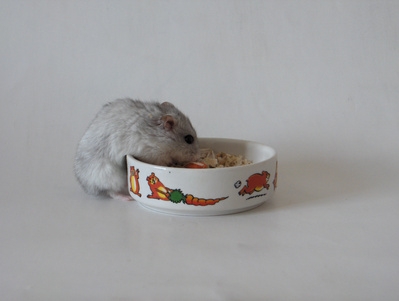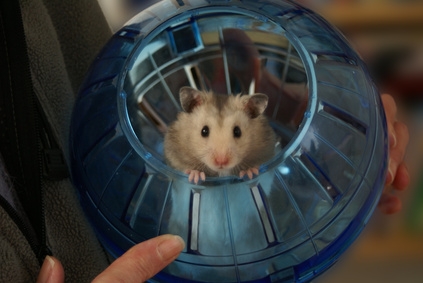
How Does a Cat Get Worms?. In order for a cat to become a host for tapeworms, the cat must first be exposed to fleas. The fleas are carriers of worms; flea larvae ingest tapeworm eggs, which does not kill the eggs but instead provides a suitable place for them to develop. This is one reason it's vitally important to kill not just adult fleas when trying to destroy pests, but to clean contaminated bedding, clothes and furniture as well. When the cat is bitten by the flea, the cat bites and chews at the sore area, usually swallowing the flea. Once inside the cat's digestive tract, the tapeworm eggs will hatch and develop into tapeworms. There is also another kind of tapeworm that uses a small rodent (a mouse, rat or rabbit) as a host. This acts much in the same way as the flea does. Once the cat eats the rodent, it becomes infected with the worms the rodent was carrying. The most common type of tapeworm is called Dipylidium caninum. Tapeworms can be found almost anywhere in the world and most infections are similar in nature.

In order for a cat to become a host for tapeworms, the cat must first be exposed to fleas. The fleas are carriers of worms; flea larvae ingest tapeworm eggs, which does not kill the eggs but instead provides a suitable place for them to develop. This is one reason it's vitally important to kill not just adult fleas when trying to destroy pests, but to clean contaminated bedding, clothes and furniture as well. When the cat is bitten by the flea, the cat bites and chews at the sore area, usually swallowing the flea. Once inside the cat's digestive tract, the tapeworm eggs will hatch and develop into tapeworms. There is also another kind of tapeworm that uses a small rodent (a mouse, rat or rabbit) as a host. This acts much in the same way as the flea does. Once the cat eats the rodent, it becomes infected with the worms the rodent was carrying. The most common type of tapeworm is called Dipylidium caninum. Tapeworms can be found almost anywhere in the world and most infections are similar in nature.
The tapeworm has a uniquely shaped mouth with hooks for attaching itself to the inside lining of the cat's small intestine. The tapeworm has a segmented body, and can grow up to 28 inches long. There are some forms of tapeworms that can grow to be up to 6 feet long, but are a less common and more specialized type of worm. This generally causes no discomfort to the cat, but weight loss, diarrhea or even a change in appearance may be noticeable in a heavily infected cat.
As the tapeworm matures in the digestive system of the cat, segments of the worm will break off and pass through the cat's system. The segments, called proglottids, can be seen in the cat's stool and often are the first signs of an infection. The proglottids contain tapeworm eggs, and from here are passed on into the system of fleas.
The best way to prevent a cat from getting tapeworms is to eliminate the parasite that carries it. Check with your veterinarian to see what preventative flea medications they would recommend, and make sure you keep your cat up-to-date on these medications. Most are applied externally to the nape of the neck on a monthly basis. If the cat does pick up fleas, make sure that you take care of the fleas not only on the cat, but any that might be left on bedding, furniture, or on other pets. Keep an eye on the cat's litter box, if possible, to see if there are any signs of tapeworm eggs being passed.
 How to Identify Infant Mice & Rats
How to Identify Infant Mice & Rats
How to Identify Infant Mice & Rats
How to Identify Infant Mice & Rats
 How to Raise a Pet Chameleon
How to Raise a Pet Chameleon
How to Ra
How to Raise a Pet Chameleon
How to Raise a Pet Chameleon
How to Ra
 Do Hamsters Eat Mealworms?
Do Hamsters Eat Mealworms?
Do Hamsters
Do Hamsters Eat Mealworms?
Do Hamsters Eat Mealworms?
Do Hamsters
 How to Make a Hamster Maze
How to Make a Hamster Maze
How to Make
How to Make a Hamster Maze
How to Make a Hamster Maze
How to Make
 Types of Pet Rodents
Types of Pet Rodents
Types of Pet Rode
Types of Pet Rodents
Types of Pet Rodents
Types of Pet Rode
Copyright © 2005-2016 Pet Information All Rights Reserved
Contact us: www162date@outlook.com